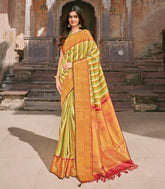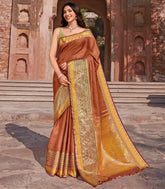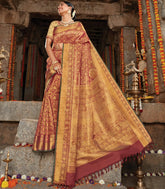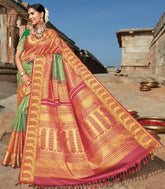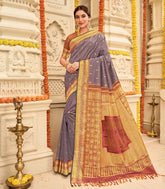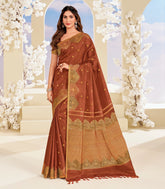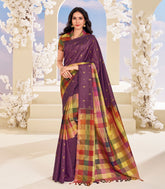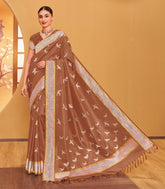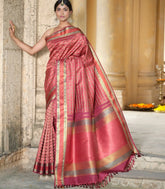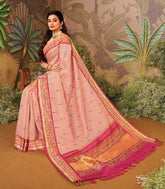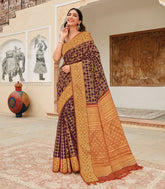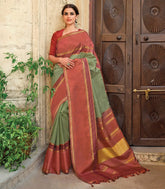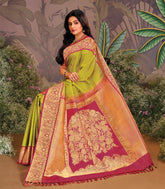-
Pink Handloom Natural Dyed Swastik Kamalam Motif Kanchipuram Tissue Silk Saree
Walk with elegance in our breathtaking Kamlam saree from RmKV Revival Saree Collection. This Kanchipuram Silk Saree is a perfect blend of tradition and nature. The delicate kamalam motifs woven with golden zari look enchanting on the body. The exotic light peach-coloured Kamalam saree...MRP:- ₹80,950
- ₹80,950
- Unit price
- per
-
Multi Color Handwoven Natural Dyed Kanchipuram Vazhaipoo Stripes Saree
In the heart of tradition, RmKV Design Studio weaves a masterpiece of colors and heritage with the "Vazhipoo Stripes" Handwoven Naturally dyed Silk Saree using turmeric, myrobalan, and mulberry leaves. Drape yourself in this tale spun by tradition, colors, and nature's brushstrokes—an embodiment of...MRP:- ₹45,950
- ₹45,950
- Unit price
- per
-
Rust Handwoven Natural Dyed Kanchipuram Bhujodi Motif Saree -Rust
Behold a masterpiece that captures the very essence of understated elegance, where simplicity meets time-honoured craftsmanship. RmKV Design Studio presents a revelation of artistry and tradition, the Bhujodi silk saree. Dyed with the hues of Indian madder, the saree's plain yet soulful body reflects...MRP:- ₹40,450
- ₹40,450
- Unit price
- per
-
Crimson Handloom Natural Dyed Kanchipuram Revival Silk Saree With Gandaberunda Motifs
This magnificent Gandaberunda saree from the RmKV Revival silk sarees Collection is inspired by the palace of Mysore. Floral motifs in a Jaal pattern fill the body, their flowers adorned in luminous gold zari add to the crimson hues obtained from naturally dyed Lac....MRP:- ₹82,150
- ₹82,150
- Unit price
- per
-
Green Handloom Natural Dyed Kodali Karuppur Inspired Kanchipuram Revival Silk Saree
Only the nobility of Thanjavur were said to have adorned the weaves of Kodali karuppur in the late 18th - early 19th centuries. The Karuppur designs, revived by the master weavers of RmKV, have now been reimagined in Kancheevaram weave. The body is adorned...MRP:- ₹94,950
- ₹94,950
- Unit price
- per
-
Lavender Handloom Kanchipuram natural dyed silk saree with Hase Chittara Motifs
A Folk Art treasure from the verdant Malnad region of Karnataka, this handwoven silk saree is a celebration of festive spirit and cultural heritage. Naturally dyed in Indian Madder and Lac, the saree is a feast, with its intricate patterns. Its exquisite pallu features...MRP:- ₹48,950
- ₹48,950
- Unit price
- per
-
Rustic Brown Handloom Natural Dyed Chrysanthemum Silk Saree With Running Border-KA12627
This exquisite saree, conceptualised, designed and handwoven by RmKV master weavers is naturally dyed using a delicate blend of Indian madder, myrobalan, lac, and mulberry leaves. Its standout feature is the running border, where the body and border merge seamlessly in a fluid weave...MRP:- ₹40,950
- ₹40,950
- Unit price
- per
-
Multicolour Checks Handloom Natural Dyed Muppagam Silk Saree -KA12628
This naturally dyed silk saree was conceptualised, designed and handwoven by RmKV master weavers.Dyed using a rich palette of natural ingredients like myrobalan, indigo, lac, sappan wood, and Indian madder, this saree is a celebration of heritage and harmony. At its heart lies the...MRP:- ₹40,950
- ₹40,950
- Unit price
- per
-
Mocha Mousse Handloom Natural Dyed Silk Saree With Japanese Cranes-KA12633
A silk saree naturally dyed in the colour of the year: Mocha Mousse. This rich, earthy hue is achieved through an artisanal blend of betel nut and catechu, forming a striking monotone canvas with understated elegance. Gliding across this mocha expanse are motifs of...MRP:- ₹34,950
- ₹34,950
- Unit price
- per
-
Crimson Handloom Kanchipuram Natural Dyed Silk Saree with Meena Zari Checks
This naturally-dyed, handwoven Kanchipuram silk saree is a masterpiece for its blend of colour and design. Lac resin (arraku) has been used to colour the body a rich crimson. The gold zari kattam (checked) pattern is the most distinctive part of the saree; each...MRP:- ₹45,950
- ₹45,950
- Unit price
- per
-
Peach Fuzz Handloom Natural Dyed Silk Saree With Muniya Buttas
Behold the resplendent silk saree by the esteemed RmKV Design Studio, a veritable treasure of natural beauty and traditional artistry. This marvel of craftsmanship features a body dyed with the alluring peach fuzz “Colour of the Year”, achieved through the meticulous use of natural...MRP:- ₹41,950
- ₹41,950
- Unit price
- per
-
Maroon Handloom Natural Dyed Silk Saree With Minangkabau Motifs
Introducing the Exquisite Kanchipuram Lac-Dyed Silk Saree by RmKV: A Fusion of Tradition and Elegance Immerse yourself in the timeless beauty of the Kanchipuram silk saree, a masterpiece meticulously crafted by the artisans at RmKV Design Studio. This exquisite piece of art is more...MRP:- ₹50,950
- ₹50,950
- Unit price
- per
-
Crimson Handloom Natural Dyed Kanchipuram Revival Silk Saree With Meenakari Parrot Motifs
he Uppada Parrot from the Revival Silk Saree Collection is a stunning piece that emanates a regal aura with its vibrant crimson hue. The skillfully woven body features the intricate jacquard weave, which adds to the grandeur of the Uppada Parrot. The crimson shade...MRP:- ₹83,950
- ₹83,950
- Unit price
- per
-
Mint Green Handloom Kanchipuram Natural Dyed Korvai Silk Saree
This classically chic handwoven Kanchipuram korvai silk saree has been naturally dyed with mulberry leaves and Indian madder (manjistha). The mint green tone comes from mulberry leaves, and the simplicity of the design only underlines the subtle beauty of the colour. The contrast korvai...MRP:- ₹29,950
- ₹29,950
- Unit price
- per
-
Pastel Green Handloom Natural Dyed Silk Saree With Tree of Life Pallu
This exquisite saree from RmKV Design Studio is a true testament to the art of natural dyeing and intricate handweaving. The saree is dyed using traditional ingredients such as myrobalan, mulberry, and lac, which impart a unique and vibrant hue to the fabric. The...MRP:- ₹50,950
- ₹50,950
- Unit price
- per
Subscribe To Our Newsletter
Receive early access to new arrivals, sales, exclusive content, events and much more!



